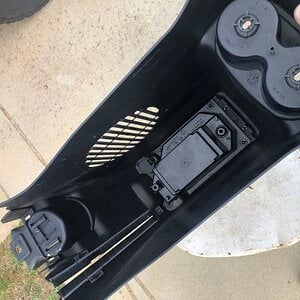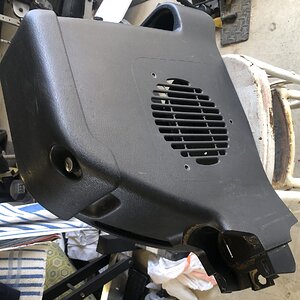Here is the dilemma, safely protect the alternator with a valid charging current. Avoid an over-current draw at low RPMs to ensure the alternator doesn't overheat while charging lithium. PRACTICALLY making a static charging state limited and mandatory for lithiums at the expense of largely discharging lithium while at load. As a result, its detrimental to substantially load lithium itself, moreover due to the power draw from audio. I have yet to manage a dummy load to the alternator and find out the exacts..BUT finding a happy dynamic between the alternator charge current off a 250 amp alt and discharge current is the ultimate goal here..
The 250 HO setup runs to a 300ah lithium axillary separated by nvx bir500 amp relay isolator from two starters, both 55ah AGM optima blue tops. Only needed, if only suitable, to solve parasitic voltage drop of lithium and AGM...:{. I would like to look for solving the low resistance of the lithium drawing too much current at idle and crippling the alternator for starters.
One way of charging is a DC to DC charger for all intents and purposes is meant to charge a standing lithium bank that isn't currently on any load, particularly a massive equipment wattage draw. If at any moment, or lack thereof, the discharge current doesn't exceed 40 amps of the DC to DC charger due to car accessories and audio amps then it may just do its job and charge the lithium battery, even for an instant.....
Low and behold there's another way of reaching a higher limiting charging state as well... The two AGMs and the lithium battery may be run in parallel, but all the audio equipment is wired directly to lithium. So let's go in between with really my only other option. To rely on an external victron BMS that can electronically limit the charging current to the lithium battery from 0-125 amps. Between it and the audio equipement is the lithium powering the whole darn system(dont forget AGMs are also in parallel being also limited to 125amps to rest of the system too). So without burning the alternator coils, what is a recommended charge current for a traditional AGM system vs lithium system that draws anywhere between 500-5000 watts at any given moment, especially working in tandem, in this case? And how can i ensure that the lithium battery doesn't just drain excessively now with a limited charge capacity too?!
Because the NVX isolator relay wires the AGM and lithium in parallel with a BMS going to the lithium that powers all the audio equipment, the lithium can only ever be able to reach a max 125amp charge current of the alternator AND similarly any needed draw from the two AGMs wired in parallel for POWA.
Victron Energy Battery Management System 12/200
Victron Energy Battery Management System BMS 12/200 | Northern Arizona Wind & Sun (solar-electric.com)
Should I just run the relay isolator to connect all batteries in parallel and run wires from Every amp or audio accessory straight off the lithium bank? If the car audio system averages a discharge of 1000-2500 watts constantly but only charges 125 amps continuously, how would the lithium battery ever get a charge? Run it with BMS locked at 80/125amps or without and find out how the alternator handles the heat?
The upside to all this limiting current is that my starter batteries should always work but the downside is limited current reaching the audio equipment.switchback to letting lithium take the blunt force..... split the amp load between the two battery banks? Lithium powers the high side and AGM powers the low side, vice versa or just Let the lithium bleed dry and recharge with LiFePO charger with car off?
The 250 HO setup runs to a 300ah lithium axillary separated by nvx bir500 amp relay isolator from two starters, both 55ah AGM optima blue tops. Only needed, if only suitable, to solve parasitic voltage drop of lithium and AGM...:{. I would like to look for solving the low resistance of the lithium drawing too much current at idle and crippling the alternator for starters.
One way of charging is a DC to DC charger for all intents and purposes is meant to charge a standing lithium bank that isn't currently on any load, particularly a massive equipment wattage draw. If at any moment, or lack thereof, the discharge current doesn't exceed 40 amps of the DC to DC charger due to car accessories and audio amps then it may just do its job and charge the lithium battery, even for an instant.....
Low and behold there's another way of reaching a higher limiting charging state as well... The two AGMs and the lithium battery may be run in parallel, but all the audio equipment is wired directly to lithium. So let's go in between with really my only other option. To rely on an external victron BMS that can electronically limit the charging current to the lithium battery from 0-125 amps. Between it and the audio equipement is the lithium powering the whole darn system(dont forget AGMs are also in parallel being also limited to 125amps to rest of the system too). So without burning the alternator coils, what is a recommended charge current for a traditional AGM system vs lithium system that draws anywhere between 500-5000 watts at any given moment, especially working in tandem, in this case? And how can i ensure that the lithium battery doesn't just drain excessively now with a limited charge capacity too?!
Because the NVX isolator relay wires the AGM and lithium in parallel with a BMS going to the lithium that powers all the audio equipment, the lithium can only ever be able to reach a max 125amp charge current of the alternator AND similarly any needed draw from the two AGMs wired in parallel for POWA.
Victron Energy Battery Management System 12/200
Victron Energy Battery Management System BMS 12/200 | Northern Arizona Wind & Sun (solar-electric.com)
Should I just run the relay isolator to connect all batteries in parallel and run wires from Every amp or audio accessory straight off the lithium bank? If the car audio system averages a discharge of 1000-2500 watts constantly but only charges 125 amps continuously, how would the lithium battery ever get a charge? Run it with BMS locked at 80/125amps or without and find out how the alternator handles the heat?
The upside to all this limiting current is that my starter batteries should always work but the downside is limited current reaching the audio equipment.switchback to letting lithium take the blunt force..... split the amp load between the two battery banks? Lithium powers the high side and AGM powers the low side, vice versa or just Let the lithium bleed dry and recharge with LiFePO charger with car off?
Last edited:


